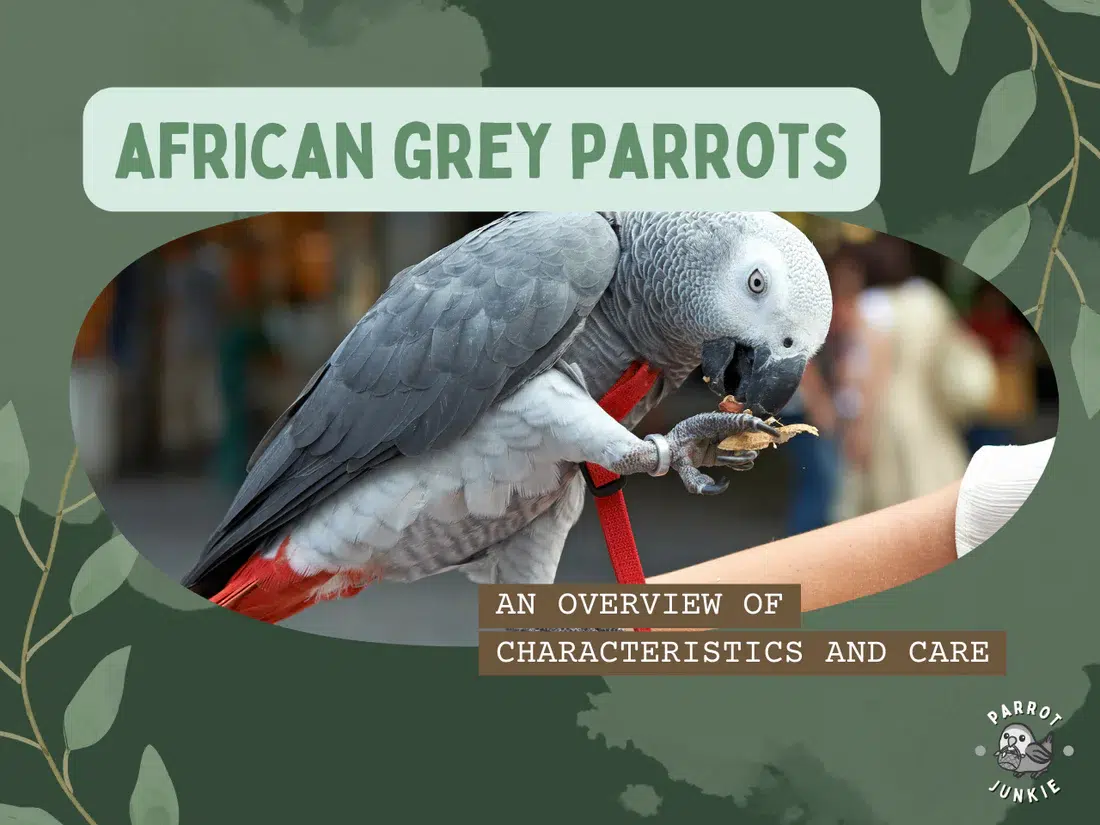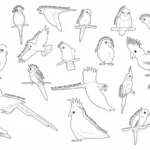
African Grey Parrots: An Overview of Characteristics and Care
African Grey parrots, known for their intelligence and striking appearance, are among the most popular avian companions in the world. Native to the dense rainforests of West and Central Africa, these birds have captured the hearts of bird enthusiasts and pet owners alike. Their ability to mimic human speech and understand complex concepts is a strong sign of their avian intelligence, making them a subject of both admiration and scientific study.
This blog article aims to explore the many facets of African Grey parrots, from their natural habitat and physical characteristics to their behavioral patterns, dietary needs, and environmental requirements. We’ll delve into what makes these parrots unique, how to care for them in a domestic setting, and their health and lifespan. By understanding these, we can appreciate the African Grey not just as a pet, but as a species that is as complex as it is captivating.
Jump To Section
Where African Grey Parrots Live In Nature
African Grey parrots, known for their intelligence and grey plumage, are native to the rainforests of West and Central Africa. There are two main species of African Grey parrots: the Congo African Grey (Psittacus erithacus), abbreviated as “CAG” and the Timneh African Grey (Psittacus timneh), abbreviated as “TAG”. The Timneh was formerly classified as a subspecies of the Psittacus erithacus, but is now known as a distinct species.
The Congo African Grey, the larger of the two species, is found in a range that extends from the northeastern Ivory Coast through to western Kenya, northwestern Tanzania, and southern Democratic Republic of Congo. They are characterized by their light grey feathers, bright red tails, and a black beak.
On the other hand, the Timneh African Grey is smaller and has a darker, charcoal-grey coloring with a maroon tail and a horn-colored upper mandible. Their range is more limited, primarily located in the western parts of the Ivory Coast and through to Guinea.
These birds inhabit a variety of forested environments, including dense, primary rainforests and more open, secondary forests. They are also seen in gardens and cultivated areas near human habitation. Their habitats provide essential resources like fruits, nuts, and seeds, and offer shelter and nesting sites in the tall forest trees.
Despite their adaptability, African Grey parrots face threats from habitat destruction and the illegal pet trade, resulting in the need for ongoing conservation efforts to protect these species and their natural environments.
Physical Characteristics of African Grey ParroTS
African Grey parrots are not only known for their intelligence but also for their distinctive physical appearance. Both species of African Grey parrots – the Congo African Grey and the Timneh African Grey – share several common features but also have notable differences.
The Congo African Grey is the larger of the two, typically measuring around 12 to 14 inches (30-36cm) in length. They have a striking light grey plumage over most of their bodies, with a beautifully contrasting bright red tail. The area around their eyes is devoid of feathers, revealing a patch of light skin. These parrots have black beaks, which are strong and perfectly adapted for cracking nuts and seeds.
In contrast, the Timneh African Grey is slightly smaller, averaging about 9 to 11 inches (23-28cm) in length. They have a darker, charcoal-grey plumage and a maroon tail. Their beaks are a distinctive feature, with the upper part being horn-colored, which differentiates them from their Congo counterparts. The Timneh’s eye area also lacks feathers, similar to the Congo, but their skin patch is often darker.
Both species have strong, muscular legs and zygodactyl feet, meaning they have two toes pointing forward and two backward. This arrangement is ideal for grasping and manipulating objects, contributing to their reputation as skilled manipulators.
Sexual Dimorphism in African Grey Parrots
African Grey parrots are not only distinguished by their intelligence and appearance but are believed to also exhibit sexual dimorphism. According to some breeders, sexual dimorphism is evident for the Congo African Grey, which become more evident after their first molt.
In Congo African Grey parrots, males are believed to have a solid red color on the underside of their tail feathers (the secondary retrices), while some females’ tails are tipped with silver (while others are also solid red, like the males). Another notable difference lies in the coloration under their wings. Males generally have a very dark shade underneath their wings, whereas females display a lighter grey color. These visual markers may be useful for pet owners, but not quite as reliable for breeders forming new pairs.
However, it’s important to note that these distinctions are specific to the Congo African Grey and do not apply to the Timneh African Grey. The Timneh Grey does not exhibit the same level of sexual dimorphism, making visual sex determination more challenging for this subspecies.
It is worth noting that these observations are anecdotal, and the best way to determine the bird’s sex is via DNA testing.
African Grey Parrots’ Behavior and Personality
African Grey parrots are renowned for their remarkable behavior and personality traits, making them one of the most intriguing bird species to interact with. Both the Congo and Timneh African Greys exhibit a range of behaviors and temperaments that are fascinating to observe and crucial for owners to understand.
- Intelligence and Mimicry: African Grey parrots are celebrated for their exceptional intelligence and ability to mimic human speech. They can learn a vast vocabulary and use it contextually, which is rare among birds. This ability is not just limited to mimicking sounds; they can understand and respond to simple questions and commands, showcasing a level of cognitive ability akin to that of young children.
- Emotional Sensitivity: These parrots are emotionally sensitive and can form strong bonds with their owners. They require attention and affection, and can become distressed if neglected. Owners need to spend quality time with their birds, engaging in activities that stimulate them both mentally and physically.
- Need for Social Interaction: African Greys are social creatures. In the wild, they live in flocks and maintain close relationships. In captivity, they seek similar social interaction, either with their human family members or other birds. Isolation can lead to behavioral issues like feather plucking or aggression.
- Playfulness and Curiosity: They are naturally curious and playful, which means they need a variety of toys and activities to keep them engaged. Without proper mental stimulation, they can become bored and develop destructive habits.
- Sensitivity to Environment: African Greys are sensitive to their environment. They can be disturbed by changes in their routine or surroundings, and may react by becoming withdrawn or displaying negative behaviors. Consistency and a stable environment are key to their well-being.
Understanding and catering to these behavioral aspects are vital for anyone considering an African Grey as a pet. Their complex personalities require commitment, but the reward is a deep and fulfilling companionship.
African Grey Parrots’ Dietary Requirements
The diet of African Grey parrots plays a crucial role in their overall health and well-being. In the wild, their diet consists of a variety of fruits, nuts, seeds, and even some insects and snails. For those keeping African Greys as pets, replicating a diet that is as close to their natural diet as possible is essential for their physical and mental health.
Variety and Balance: A well-balanced diet for an African Grey should include a variety of fresh fruits and vegetables, high-quality pellets, and a limited amount of seeds and nuts. Fruits and vegetables not only provide essential vitamins and minerals but also offer hydration and enrichment. However, it’s important to be aware of which foods are safe for parrots, as some common foods can be toxic to them.
Pellets: Pellet-based diets are often recommended because they are nutritionally balanced. However, pellets should not be the sole component of their diet. Integrating fresh produce ensures that the birds receive a variety of nutrients and textures, which is beneficial for their health and keeps them engaged.
Seeds and Nuts: While seeds and nuts can be a part of their diet, they should be given in moderation due to their high fat content. These can be used as treats or for training purposes.
Calcium and Vitamin Supplements: African Grey parrots require more calcium than some other parrot species and are more prone to hypocalcemia (calcium deficiency). In some cases, supplements may be necessary, especially if the bird is not getting enough from its diet. However, any supplementation should be done under the guidance of a veterinarian.
Fresh Water: Fresh, clean water should be available at all times. It’s important to change the water daily to prevent bacterial growth.
It’s crucial to monitor the bird’s weight and health regularly to ensure that their dietary needs are being met. An imbalanced diet can lead to health issues such as vitamin deficiencies, obesity, and feather problems. Consulting with a veterinarian experienced in avian care is advisable to create a diet that suits the specific needs of your African Grey.
Housing and Environmental Needs
Proper housing and a suitable environment are essential for the health and happiness of African Grey parrots. These intelligent birds require a living space that not only keeps them safe but also stimulates their active minds and bodies.
Cage Size and Setup
Size: The cage for an African Grey should be spacious enough to allow for free movement. A good rule of thumb is to choose a cage where the width is at least twice the bird’s wingspan. Ideally, a cage measuring 2 feet (60cm) deep by 3 feet (90cm) wide by 4 feet (120cm) tall should be the minimum. However, larger is always preferable. This size ensures that the bird can stretch its wings and move around comfortably without feeling cramped.
Bar Spacing: The spacing between the bars should be appropriate to prevent the bird from getting its head stuck or escaping. Typically, bar spacing of about 0.5 to 0.75 inches (1.3 to 1.9cm) is suitable for African Greys.
Material: The cage material should be sturdy and non-toxic. Stainless steel is often recommended because it’s durable, easy to clean, and rigid enough to withstand the chewing of African Greys’ strong beaks.
Placement: Position the cage in a location that is safe and comfortable for the bird. It should be away from direct sunlight, drafts, and kitchen fumes. The area should be socially engaging, allowing the bird to interact with family members without being in the midst of high traffic or noisy areas.
Perches: Inside the cage, provide various perches of different sizes and textures to mimic the natural environment and promote foot health. Natural wood perches of different textures are excellent as they vary in diameter and texture.
Toys and Mental Stimulation
Toys and mental stimulation play a vital role in the life of an African Grey parrot. These intelligent birds require regular mental stimulation to stay happy and healthy. Without it, they can develop behavioral problems such as feather plucking, aggression, or excessive vocalization.
Variety of Toys: It’s important to provide a variety of toys to cater to different aspects of the parrot’s intelligence and natural behaviors. This can include chew toys, foraging toys, puzzle toys, natural (not cotton or fabric) ropes, and swings. African Greys are known to be great problem solvers, so toys that challenge them mentally are particularly beneficial.
Foraging Toys: In the wild, African Greys spend a significant amount of time foraging for food. Mimicking this behavior in captivity is important for their mental health. Foraging toys that require them to work for their food can provide hours of mental stimulation and mimic natural behaviors.
Rotating Toys: To keep the African Grey engaged and interested, regularly rotate the toys in the cage. This not only prevents boredom but also stimulates their curiosity and intelligence.
Interaction and Training: Engaging directly with your African Grey through training sessions and interactive play can significantly contribute to their mental stimulation. Teaching them new words, commands, or tricks can be both rewarding and mentally enriching for the bird.
Safe Materials: Ensure that all toys and materials used are safe and non-toxic. African Greys are known to chew and explore with their beaks, so any ingested material should be bird-safe.
By providing a stimulating environment with a variety of toys and interaction, you can help ensure that your African Grey remains engaged, happy, and mentally healthy.
Light and Temperature
Proper lighting and temperature control are essential aspects of caring for an African Grey parrot. These factors not only affect their physical health but also their mental well-being.
Light: Adequate lighting is crucial for African Greys. Natural sunlight provides Vitamin D3, which is essential for calcium metabolism. However, direct exposure to sunlight can be harmful, so it’s important to provide filtered sunlight or a safe outdoor aviary. If natural light is not sufficient, especially in colder climates or during winter months, full-spectrum artificial lighting can be used to supplement. These lights should mimic natural daylight patterns, providing around 12 hours of light per day.
Temperature: African Greys, being native to a tropical climate, thrive in warm temperatures. It’s important to avoid sudden temperature changes and drafts, as these can cause stress and health problems. In colder climates, supplemental heating may be necessary to maintain a consistent temperature.
Humidity: These parrots also require a certain level of humidity, ideally around 50-60%. Low humidity can lead to respiratory issues and feather problems. In dry environments, using a humidifier or regularly misting the bird can help maintain the appropriate humidity levels.
Nighttime Conditions: At night, African Greys need a quiet, dark environment to sleep. Covering the cage at night can help provide a sense of security and maintain a regular sleep cycle.
Providing the right light and temperature conditions is vital for the health and comfort of African Grey parrots, ensuring they lead a happy and healthy life in captivity.
Environmental Safety
Ensuring a safe environment is paramount when caring for African Grey parrots. Due to their curious nature and tendency to explore with their beaks, it’s crucial to make their living space as hazard-free as possible.
Toxic Substances: Keep the bird’s environment free from toxic substances. Common household items such as certain plants, non-stick cookware (which releases harmful fumes when overheated), scented candles, and air fresheners can be toxic to parrots. It’s important to be aware of and eliminate these potential hazards from areas accessible to the bird.
Secure Windows and Doors: African Greys are clever and may learn to open cages or doors. Ensure that all windows and doors are secure to prevent accidental escape. If the bird is allowed out of its cage, this should always be under supervision, especially in homes with other pets or potential dangers.
Electrical Cords and Small Objects: Birds might chew on electrical cords, which can be dangerous. Keep these out of reach or cover them with protective casings. Also, small objects that can be swallowed or chewed should be kept away from the bird’s environment.
Cleanliness: Regular cleaning of the cage and accessories is important to prevent bacterial and fungal growth. Replace toys and perches when they become worn or damaged.
Air Quality: Good ventilation is important, but drafts should be avoided. Ensure that the room where the bird is kept has clean, fresh air, but is not directly in the path of air conditioning or heating vents.
By taking these precautions, you can create a safe and healthy environment for your African Grey, allowing them to explore and play without the risk of injury or illness.
Socialization and Interaction with African Grey Parrots
Socialization and interaction are critical components in the care of African Grey parrots. These intelligent and social birds require regular engagement to maintain their mental and emotional health.
Importance of Socialization: In the wild, African Greys are social creatures that live in flocks. In captivity, they need to fulfill this social aspect through interaction with their human family or other birds. Lack of socialization can lead to behavioral problems such as aggression, excessive vocalization, or feather plucking.
Regular Interaction: It’s important for owners to spend quality time with their African Grey each day. This can include talking to the bird, teaching it new words or tricks, and allowing it out of the cage for supervised play and exploration. This interaction not only strengthens the bond between the bird and its owner but also provides necessary mental stimulation.
Training: African Greys respond well to positive reinforcement training. This can be an effective way to teach your bird desired behaviors, tricks, and speech. Training sessions are also a great opportunity for mental exercise and bonding.
Handling: Gradually and gently handle your African Grey to get it accustomed to human touch. This helps in building trust and makes it easier to manage routine activities like grooming or veterinary check-ups.
Social Environment: If possible, allow your African Grey to interact with other birds in the household, under close supervision. However, always be cautious and introduce them gradually to ensure compatibility and safety. Never allow your African Grey parrot to interact closely with predatory pets, such as dogs and cats.
Avoiding Stress: Be aware of signs of stress or discomfort in your bird, such as feather plucking, aggression, or changes in eating habits. A stressed bird may need more attention, a change in environment, or a consultation with an avian veterinarian.
By providing your African Grey with regular socialization and interaction, you can ensure a happy, healthy, and well-adjusted companion.
African Grey Parrots’ Health and Lifespan
The health and lifespan of African Grey parrots are major considerations for anyone looking to keep these birds as pets. With proper care, African Greys can live for a very long time, often reaching 40 to 60 years in captivity, and sometimes even longer. This means that some African Grey parrots may even outlive their owners! It is important to have a plan to have someone take over your pet in the event they outlive you.
Regular Veterinary Care: Regular check-ups with an avian veterinarian are crucial to ensure your African Grey stays healthy. These check-ups can help detect and prevent potential health issues early. Vaccinations and routine tests for common bird diseases are part of good preventive care.
Diet and Nutrition: As mentioned earlier, a balanced diet is vital for the health of African Grey parrots. Nutritional deficiencies, especially a lack of calcium or Vitamin A, can lead to health problems. A diet consisting of quality pellets, fresh fruits and vegetables, and a controlled amount of seeds and nuts is recommended.
Exercise: Adequate exercise is important to maintain physical health and prevent obesity. Allow your African Grey time outside of its cage daily to stretch, fly, and engage in play.
Mental Health: Mental health is just as important as physical health for African Greys. Boredom and stress can lead to behavioral and health problems like feather plucking or self-mutilation. Regular interaction, mental stimulation, and a safe environment are key to keeping your bird mentally healthy.
Signs of Illness: Be aware of signs of illness, such as changes in eating or bathroom habits, lethargy, ruffled feathers, or changes in vocalization. Early detection and treatment of illness are crucial.
Environmental Factors: Maintain a clean, safe, and stable environment. Avoid exposure to toxins, smoke, and extreme temperatures or humidity levels.
Providing your African Grey with the right care, diet, and environment can help ensure a long, healthy, and fulfilling life.
Breeding and Reproduction
Breeding African Grey parrots can be both a challenging and rewarding experience. It requires a deep understanding of their behavior, needs, and the specific conditions necessary for successful breeding.
Maturity: African Greys typically reach sexual maturity between 3 and 5 years of age. However, it’s generally recommended to wait until they are at least 5 years old before starting a breeding program.
Pair Bonding: These parrots often form strong pair bonds. Choosing compatible pairs is crucial for successful breeding. Compatibility can be determined through observed interactions and behaviors. It’s important to note that forced pairings can lead to aggression or stress.
Breeding Environment: The environment plays a significant role in breeding. African Greys require a quiet, secure, and stress-free environment to breed successfully. They need a large, comfortable nesting box where the female can lay her eggs and care for her young.
Egg Laying and Incubation: The female typically lays 2 to 4 eggs per clutch. She will incubate the eggs for about 28 to 30 days. During this time, it’s important to ensure that the breeding pair is not disturbed and that the female has access to a nutritious diet.
Rearing Chicks: Parent African Greys usually take good care of their chicks. In some cases, hand-rearing may be necessary, especially in a commercial breeding setting. Hand-rearing requires specific skills and a great deal of time and dedication.
Health and Genetics: Before breeding, it’s advisable to have the birds checked by an avian veterinarian to ensure they are healthy and free from genetic disorders that could be passed on to the offspring.
Legal Considerations: It’s important to be aware of and comply with any legal requirements for breeding African Grey parrots, especially given their status with CITES (the Convention on International Trade in Endangered Species of Wild Fauna and Flora).
Breeding African Grey parrots should be undertaken with a commitment to the welfare of the birds and the sustainability of the species. It requires a significant investment of time, resources, and knowledge.
Conclusion
African Grey parrots are extraordinary creatures, renowned for their intelligence, personality, and striking appearance. Through this article, we have explored various aspects of their lives, including their natural habitat, physical characteristics, diet, housing, and social needs. We’ve also delved into their health, lifespan, and breeding.
Caring for an African Grey requires a deep understanding of their needs and a strong commitment to their wellbeing. These birds are not just pets but intelligent beings that require mental stimulation, social interaction, and emotional bonding. The rewards of caring for an African Grey are immense, offering a unique companionship that is both enriching and fulfilling.
Whether you are a seasoned African Grey owner or considering bringing one into your home, it is essential to remember the responsibility that comes with caring for such a complex and long-lived bird. Their care demands time, patience, and dedication, but in return, they offer unparalleled affection and companionship.
In conclusion, African Grey parrots are not only a testament to the beauty and intelligence of the avian world but also a reminder of our responsibility to protect and understand the creatures we share our planet with. Their presence in our lives is a privilege that should be cherished and respected.
Parrot Junkie www.parrotjunkie.com
Copyright © 2021-2024. All rights reserved.



Be the first to leave a comment